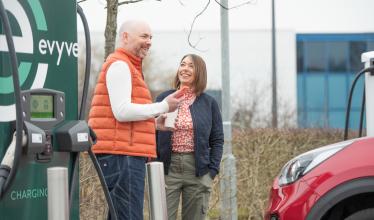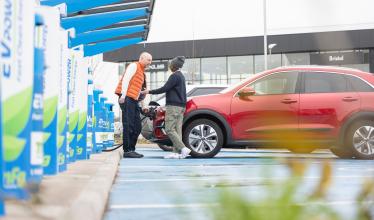With 2016 set to see a large number of plug-in hybrid vehicles (PHEVs) launched, Zapmap started the year by getting behind the wheel of the latest model and attended the UK launch of Volvo’s XC90 T8 TwinEngine.
The new flagship Volvo features a 2.0 litre petrol engine – powering the front wheels – combined with an electric motor – attached to the rear axle – that produces a combined 407hp and 472 lb ft of torque. Considering the car weighs just under 2,300kg, it’s a good job there is plenty of oomph available under your right foot and, thanks to an advanced engine and the instant torque available from the electric motor, progress can be brisk, even considering just how large the XC90 is.
The T8 TwinEngine uses a 9.2kWh battery to allow for an official range of up to 27 miles – though in reality this is around 20-22 miles in normal driving. Charging using the car’s Type 2 socket will take around 3.5 hours from a conventional home supply, though you can knock an hour off that with a 16A home charger. The car’s default drive setting is Hybrid, which uses a blend of petrol and electric power as you go, favouring the electric motor where possible but with the petrol engine kicking in when needed.
The driver is able to select one of six different driving modes though with Pure running in electric-only, Save holding the car’s charge, Power giving the drivetrain all the power from both systems, and AWD and Off-Road making sure that traction is improved with the use of both systems intelligently.
Power goes through all four wheels via an eight-speed automatic gearbox that, as with most plug-in cars, features a ‘B’ setting for increased engine braking and therefore improved energy recuperation. Unfortunately, this braking mode could have been made far stronger, increasing the efficiency of the XC90’s electric systems by putting more charge back into the battery. The light braking set-up doesn’t give you the feeling of deceleration that you get with many other plug-in cars and that, combined with the wooden feel to the brake pedal, is the most disappointing aspect of the XC90 T8 TwinEngine.
That says a lot about how good the car is though that the feeling that the XC90 could be even more efficient is considered the main downside. With official CO2 emissions figures of 49 g/km and weighted combined fuel economy set at 134.5 MPG, the XC90 T8 TwinEngine offers exceptionally strong figures for such a large and heavy car. Of course the fuel economy statistics will rarely be achieved, but can easily be bettered depending on how far you run on electric only.
On the test routes provided – around 130 miles of hilly Cotswold roads – the car averaged between 75 and 55 MPG depending on driving style, terrain and available charge. With no charge at all, those figures drop to around 35 MPG, though obviously in Pure mode you are able to use no petrol at all for 20 miles or so. As with all PHEV’s use the XC90 T8 TwinEngine to its strengths – short runs with regular charging – and fuel costs will be exceptionally low. Even with no charge at all, fuel economy rivals that of the non-plug-in petrol version despite an extra 300kg or so to lug around, while those regularly covering large miles each trip at motorway speeds would be better off financially with a diesel-powered version.
The good news is that, no matter where you drive it and for however long, the XC90 T8 TwinEngine will prove an extremely comfortable mode of transport. The car wafts along with the best of them, brushing aside poor road surfaces or floating over smooth tarmac effortlessly. Only on roads that are becoming bumpy or that resemble a patchwork of tarmac is the suspension at its least happy. The steering wheel and pedals transmit a fair amount of feedback on this type of surface, but the rest of the time, the car is a breeze to drive around town or the motorway, ironing out pot-holes or mileages depending on the situation.
The cabin perfectly suits this comfortable set-up with seats that cosset and support, enough space to swing the proverbial in, and seating for seven. This last point is a real trump card for Volvo as its PHEV rivals need to use the space ordinarily taken up in the boot by the rearmost seats for electric powertrain systems. Because the Volvo engine and chassis was designed from the outset with electrification in mind, the XC90 is still a full seven-seater, using what would have been the transmission tunnel to house the car’s battery.
Occupants will be able to make the most of the car’s excellent Sensus infotainment system which can offer a WiFi hotspot, improved connectivity for the XC90 with Volvo’s dealers, and easy integration of the company’s On-Call system that allows the owner to pre-condition their T8 TwinEngine, find it in a car park etc. Naturally, this being a Volvo, safety systems are among the best around. In fact the XC90 scored the highest EuroNCAP crash test scores of any car in 2015.
In short then, the XC90 – one of the best cars in its class in petrol or diesel guise – is equally as good if not better with a PHEV powertrain. The space available is huge, practicality excellent, safety first class and the car’s a great choice for those who prioritise comfort over sportiness. With the potential for extremely low running costs, the XC90 T8 TwinEngine is an important model for Volvo and it delivers, offering no compromise despite the two power systems and performing as an excellent all-rounder.






